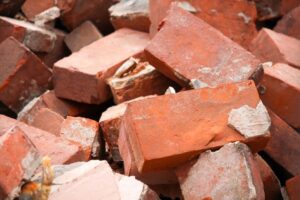Most of us don’t think much about where or how our bricks are made, we just enjoy them on our homes, schools, and businesses. For many years, however, bricks were often manufactured close to where they were actually used and Shenandoah County had several such operations. According to county historian, Fred Painter, David Hoshour started this enterprise in Woodstock in 1835 and it continued to produce quality building materials until 1920. This business provided the bricks that were used to construct many town buildings during that time period including two additions to the county courthouse. 
According to Painter, Hoshour’s original manufacturing site was on east Court Street across from Emmanuel Episcopal Church but later moved to other locations including the northeast corner of Spring and Commerce Streets and the northwest corner of Church and High Streets before finally settling on its last site between the Massanutten Cemetery and the railroad tracks.
Red clay, sand, and copious water were the primary requirements and the valley provides all three. If water was unavailable at the site, it would be hauled in by horse drawn wagons in 50 gallon drums. The ingredients were then mixed together in a large hole usually measuring four feet square by six feet deep and lined with oak boards. This was known as a pug mill and became the mixing bowl for the concoction which was termed “pug.”
A small tree would be cut and turned upside down with its branches immersed in the mixture. A long pole was fastened to the tree’s trunk and a horse was harnessed to it which circled the pit thoroughly blending all the components together.
After proper mixing, the pug was taken from the hole and thrown, rather than poured, into oak molds to prevent air pockets. As soon as the wet bricks set up, the molds were inverted and the fresh bricks were carefully removed. They air dried for several days before being stacked on racks for the kiln.
The kiln was a large outdoor oven, itself made of bricks, and could hold 30-50,000 new ones. A small fire was nursed for about 48 hours to further eliminate moisture before more intense heat was maintained for four to five additional days.
After they were fired, the bricks had to set for a week before they were cool enough to even handle, at which time they would be unloaded from the kiln and sold to local builders who then used them to construct many structures that still grace Woodstock’s streets.
As I’ve reflected on this practical local solution to the need for building components, I was struck by how the heat strengthened the bricks. Unlike some other materials that would either burn up or melt in the fire, the clay blocks absorbed the heat and were made stronger by it. Those very intense days in the furnace prepared them for decades, and even centuries, of service.
Many times we complain about difficult stresses in our lives. This is quite understandable as none of us enjoy suffering or pain. They are, however, the very processes that often remove weaknesses and prepare us to become strong, effective, and enduring building blocks in God’s kingdom. The lessons learned and the growth attained during the “kiln times” of our lives can be the very methods God uses to properly prepare us for service.
The Bible tells us in 1 Peter 2 that every Christian is a living stone being built into God’s spiritual house. It also reminds us in that Jesus Himself is the Chief Cornerstone and we are well aware of the most intense firing He endured on the cross. If our Cornerstone experienced the fire, we should not expect to escape it if we wish to be a part of His building.
The next time you see a brick structure, consider the process our ancestors used to make the bricks and may that remind you of the techniques God uses to prepare us for service in His Kingdom. Even though it’s difficult at the time, the resulting strength and endurance is of eternal worth and value.
Blessings, George